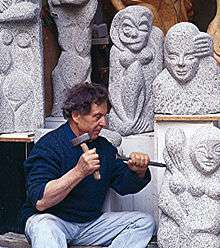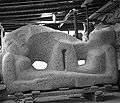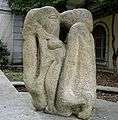Shelomo Selinger
| Shelomo Selinger | |
|---|---|
 Shelomo Selinger in his studio | |
| Born |
May 31, 1928 Szczakowa, Poland |
| Website | http://www.museum-selinger.net/ |
Shelomo Selinger (born May 31, 1928) is a French-Israeli sculptor and artist, living and working in Paris since 1956.
Biography
Shelomo Selinger was born to a Jewish family in Poland in the small town of Szczakowa (today part of Jaworzno) near Oświęcim (Auschwitz[1]). He received both a traditional Jewish upbringing and a Polish public school education. In 1943 he was deported with his father from the Chrzanów ghetto to the Faulbrück concentration camp in Germany. Three months later his father was murdered and Shelomo remained alone in the camp. His mother as well as one of his sisters also perished during the Holocaust. Shelomo Selinger survived nine German death camps: Faulbrück, Gröditz, Markstadt, Fünfteichen, Gross-Rosen, Flossenburg, Dresden, Leitmeritz and finally Theresienstadt, as well as two death marches.
He was discovered, still breathing, on a stack of dead bodies when the Terezin camp was liberated in 1945 by the Red Army. The Jewish military doctor who pulled Shelomo out of the pile of corpses transferred him to a military field hospital where he was taken care of and where he came back to life. He recovered his health but lost his memory and for seven years was completely amnesic to his past sufferings and horrors.
In 1946 Shelomo Selinger boarded the Tel Haï, a ship leaving La Ciotat and headed to the then British Mandate Palestine with a group of young death camps survivors who, with the help of the Jewish Brigade of the British Army, had crossed illegally the borders of Germany, Belgium and France. The ship was seized outside the territorial waters of Haifa by the British Royal Navy. The passengers, none of whom had a legal immigration certificate, were interned in the Atlit detainee camp.
After his liberation from this camp, Selinger joined the Beit HaArava kibbutz near the Dead Sea. During the 1948 Palestine war he participated in the Sodom battle, while his kibbutz was destroyed. Shelomo Selinger then was one of the founders of the Kabri kibbutz, in the Galilee. That's where in 1951 he met his future wife, Ruth Shapirovsky, who came to the kibbutz as a volunteer worker with her Haifa high school class. They were married in 1954. At that time Shelomo began to fill in the gaps in his memory and started to sculpt.
In 1955 Shelomo Selinger was awarded the Norman Prize of the America-Israel Cultural Foundation. A year later he enrolled in Paris at the École nationale supérieure des Beaux-Arts. He studied traditional clay modelling with the sculptor Marcel Gimond, but did not abandon his own personal style and continued carving directly on working materials with hammers, sledge hammers and chisels.
Too poor to buy his own working materials, Selinger went hunting for stone blocks in the slum belt of Paris and came back with a very dense and hard bloc of granite capable of capturing and reflecting light. Granite became his favourite stone. Romanian sculptor Constantin Brâncuși introduced him to Vosges' sandstone ("Grès des Vosges") and gave him a grindstone made of this reddish stone, a symbolic present to Shelomo as a successor to Brâncuși's direct carving technique. Selinger also carved wood, using mainly easily available firewood.
After spending three years in the Beaux Arts school, he started attending what he calls the "best school" of all, the museums of Paris. Primarily he spent time at the Louvre, and the studios of the greatest Parisian sculptors of the time, for example Ossip Zadkine, Jean Arp, Alberto Giacometti and Joseph Constant. A sculpture named "Motherhood", inspired by his wife and the birth of their son Rami, earned Selinger the Neumann Prize of the city of Geneva. It was the first acknowledgement of his talent in Paris. This work is now part of the permanent collection of the Musée d'Art Moderne de la Ville de Paris. Thus Selinger—a survivor of the German death camps of World War II—has become a renowned sculptor of birth, rebirth and life itself.
The Jewish Museum of New York discovered Selinger in 1960, putting seven of his sculptures on show, but it was the Paris art gallery owner Michel Dauberville who really recognized Selinger's genius and continuously encouraged and promoted him when he became the owner of his parents’ gallery, the Galerie Bernheim-Jeune. He exhibited Selinger's work in 1962, 1963 and 1965 and continued with showings in 1972, 1989, 1990, 1995, 1996, 2002 and 2006 and 2009.
Further recognition came to Selinger in 1973 when he won first prize in an international competition with his monument titled "The Gates of Hell" in memory of those who had passed through Drancy internment camp on the outskirts of Paris during World War II. Drancy was a major transit point for Jews arrested by French police and German occupation forces, destined for rail transport to Auschwitz and other death camps. 77,000 French Jews were deported via Drancy, including 11,204 children.
Many other awards followed. In 1973 Shelomo Selinger was named Chevalier to the prestigious French Legion of Honour by President François Mitterrand. Since 2006 Selinger bears the title "Officier de la Légion d'Honneur".
Currently living in Paris with his devoted wife, he never hesitates to tell his story of survival and to show his work for those who wish to see it. He works with marble, granite, stone, and wood. Most of his creations are of loving embraces or those that emit some type of remembrance. His work is very popular since he uses all of his own tools and his imagination is his muse. An extremely nice man, incredibly gifted, and a genius with his hands.
Citations
My partners in creation are matter and light. Every stone has its own specific personality and this has to be respected. I contemplate for a long time before I discover the dormant form inside. My task is to bring the form to light. The transition from shadow to light is the secret of sculpting. In my wood sculptures I follow the natural forms of the wood and I try to bring forth a shape that can enable light to burst forth. I am amazed time and again at how the very structure of my piece of wood, its veins and its fibres, take control of my creation. I carve directly in stone. My tools are my hammer, my chisel and my hands. I think they are perfect for conveying and reflecting my feelings. I have never used machinery. Machines follow their own pattern and their rhythm is too fast. My unquenchable thirst for freedom, as well as my quest for light, a consequence of my life in the camps, are ever-present in my work. The technique of direct hand carving in stone or wood is an everlasting remainder and reminder of my time as a prisoner digging a tunnel to freedom. The prisoner, who drills, bores and excavates, hopes to be free once his tunnel is finished and the light at the end of it is revealed. In truth he is neither free before, neither during his digging nor after his escape. My salvation is in the very act of digging and carving. Once I finish a piece I start a new one immediately. I am never short of inspiration nor of a subject.
Major works
Selinger's work on the Mémorial national des Déportés de France (French National Deportation Memorial) in Drancy, in rose coloured granite, took two years of carving by hand and was unveiled in 1976. The Mémorial de la Résistance in La Courneuve followed in 1987. In the meantime Selinger created the Requiem pour les Juifs d'Allemagne (Requiem for German Jews) (1980) in Bosen, Saarland and the Monument aux Justes parmi les Nations (Monument for the Unknown Righteous among the Nations) at Yad Vashem in Jerusalem(1987). Selinger started treating monumental statuary in open space in 1964 with his sculpture L’Esprit et la matière n° 1 (Spirit and matter n° 1), erected in Saint-Avold (Moselle), followed by L’Esprit et la matière n° 2 in Wissembourg (Bas-Rhin). The superb white marble Moise ou la Victoire de la lumière (Moses or the Victory of Light), set up in Aranđelovac (Serbia) has kept its head but the prophet's rays were destroyed by lightning.
Some of his other important open-air monuments are La tauromachie at the bullring of Le Bouscat (Gironde) in 1974, La Danse, a group of 35 flower boxes created in 1982, stretching from the place Basse of the Esplanade Charles-de-Gaulle, to the La Défense (Hauts-de-Seine), covering an area of 3.600 square meters and the Groupe de 13 sculptures (1991) in the Tel-Hai Industrial park in the Galilee, a part of the 24 granite and basalt sculptures bought by the Open Air Museum of Tefen. These works are on display in Tel-Aviv, in Omer or in Lavon. Since 1998, Le prophète Elie (The Prophet Elijah) towers over the Mount Carmel dominating Haifa.
Selinger's sculptures comprise today more than 800 works in all possible materials and sizes, granite, red granite, sandstone, marble, bronze, oak, blackwood, cherry wood, ash tree or beech. Forty-eight monumental open-air statues are exhibited in public places. Five of these monuments are dedicated to The Holocaust and the Résistance.
On the 103rd anniversary of the 1906 rehabilitation of Alfred Dreyfus, the first deputy mayor of Paris, Anne Hidalgo, announced the creation of a new association. The association proposes to launch a national subscription campaign for the erection of a statue of Émile Zola on the Place Alfred Dreyfus in the 15th arrondissement of Paris. The sculptor will be Shelomo Selinger.
Selinger's graphic works in Indian ink and/or charcoal number thousands. Part of his drawings represents his concentration camp experience, but most of his works are real celebrations of life. Shelomo Selinger’s works were exhibited in about forty museums and galleries all over the world.
Pizes and distinctions
- 1956 - Norman Prize for sculpture, America-Israel. Israel.
- 1958 - Neumann Prize for Jewish artists in Europe.
- 1973 - First Prize in the international competition for the national monument in memory of the camp at Drancy.
- 1974 – Silver Medal of the town of Montrouge.
- 1983 - Silver Medal of the town of Paris.
- 1985 - First Grand Prix at the Salon d’Automne. Paris.
- 1989 - Vermeil medal of the city of Paris
- 1991 - Prize of Yiddish journalists in Paris.
- 1993 - Chevalier de la Légion d’Honneur. Paris
- 1993 - Mémoire de la Shoah Prize, Fondation Buchman, Fondation of French Judaïsme.
- 1994 -
 Chevalier des Arts et des Lettres. Paris
Chevalier des Arts et des Lettres. Paris - 1994 - Peace Prize. Republic of China.
- 1996 - Korman Prize from the Union des Associations Juives de France.
- 2005 –
 Officier de la Légion d’Honneur.
Officier de la Légion d’Honneur.
Bibliography
- L’HOMME BLANC RACONTE SON HISTOIRE, Drawings by S.Selinger. Text by Bruno.Durocher. Paris. Edition Caractère. 1981
- Israel, Drawings by S. Selinger.Poems by David Escobar Galindo. San - Salvador. 1981
- HISTOIRE DE LA SCULPTURE MODERNE EN FRANCE DE 1950 A NOS JOURS. Lionel Jianou. Paris, Arte Edition d’art. 1982
- SET ER- HA-SETARIM, Woodcuts by Shelomo Selinger. Text by Bruno Durocher. Paris. Edition Durocher. 1986
- LE MEMORIAL NATIONAL DU CAMP DE DRANCY, Brochure published by the municipality of Drancy. 1990
- UNE ECOLE DE BATIMENT A AUSCHWITZ, Drawings by S.Selinger. Text by Charles Papiernik. Paris. Edition Caractère.1993 Buenos aires. Argentina, (in Spanish). Edition Milà. 1994
- ETRANGER, Woodcuts by Shelomo Selinger. Poetry by Bruno Durocher. Paris. Edition Caractère. 1994
- L’UNIVERS DU SCULPTEUR SHELOMO SELINGER, Text by Marie-Françoise Bonicel. Biography by Ruth Selinger. Paris. Edition F.Ferre.1998.
- Text of the speech made by François Mitterrand when awarding the artist the Légion d’Honneur.
- SHELOMO SELINGER, Sculptures in the Open Museum Collection. 2000. Tefen, Open Museum. Israel
- SHELOMO SELINGER SURVIVOR OF THE SHOAH. video cassettes Visual History Foundation. 1996
- SHELOMO SELINGER. THE DEATH CAMPS- DRAWINGS BY A SURVIVOR. Text by Marie-Françoise Bonicel et Ruth Shapirovsky-Selinger.
Paris. Somogy Edition d’Art. 2005.
Galerie
 Requiem pour les Juifs d'Allemagne 1980, Bosen
Requiem pour les Juifs d'Allemagne 1980, Bosen
 La Tauromachie, Arènes du Bouscat, Bordeaux
La Tauromachie, Arènes du Bouscat, Bordeaux Exposition dans le parc industriel de Tefen (Israël)
Exposition dans le parc industriel de Tefen (Israël) Moïse ou la victoire de la lumière, marbre blanc, Arandjelovac
Moïse ou la victoire de la lumière, marbre blanc, Arandjelovac L’esprit de la matière N°2 Wissembourg.
L’esprit de la matière N°2 Wissembourg. Cinq musiciens, Hayange
Cinq musiciens, Hayange Maternité, Musée d'art moderne de la Ville de Paris
Maternité, Musée d'art moderne de la Ville de Paris
 L’esprit de la matière N°1, Saint-Avold
L’esprit de la matière N°1, Saint-Avold Le regard, Tarbes, Hautes-Pyrénées
Le regard, Tarbes, Hautes-Pyrénées L’arbre de vie (bois) et La danse (encre de Chine)
L’arbre de vie (bois) et La danse (encre de Chine)
Filmography
- Shelomo Selinger : Mémoire de pierre, 77 minutes, French w/English subtitles, Directed by Alain Bellaïche (), 2010.
- Les sept portes de Shelomo Selinger (, 2012.
External links
| Wikimedia Commons has media related to Shlomo Selinger. |
- The Israel Museum, Jerusalem
- Film Memoire de pierre by Alain Bellaïche on YouTube.
- Les sept portes de Shelomo Selinger
- (in English) A Teacher’s guide to the holocaust, « Drancy Transit Camp Memorial »
- (in English) University of Minnesota, Center for Holocaust & genocide Studies, Pictures of Shelomo Selinger drawings
- (in English) University of Minnesota, Center for Holocaust & genocide Studies, Pictures of Shelomo Selinger's sculptures
- (in English) Parisiana, The lovers Guide To Paris
- « Selinger sculpte la lumière », article de L'Humanité du 30 octobre 1996
- Clip du film Mémoire de pierre on YouTube.
References
- ↑ Le Petit Larousse 2008, éd. Larousse, Paris ISBN 978-2-03-582503-2 Shelomo Selinger1141